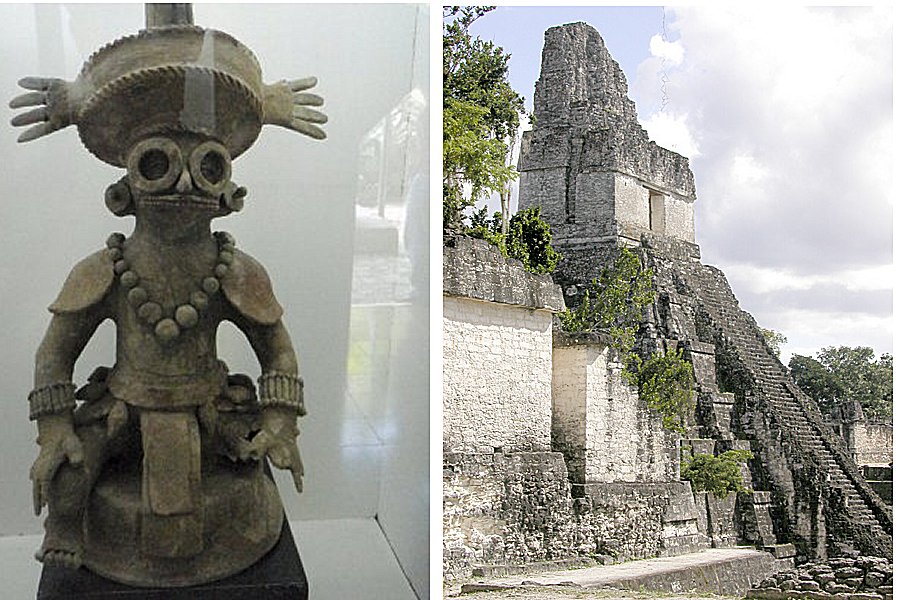A. Sutherland - AncientPages.com - An archaeological site of Copán contains the remains of ancient ruins associated with the Maya civilization. It is located in the Copán Department of western Honduras, near Guatemala's border.
Stela H at Copán, commissioned by Uaxaclajuun Ub'aah K'awiil, one of the greatest kings in Copán's dynastic history, who was captured and executed by his former vassal, the king of Quiriguá. Image via Wikipedia
Copán was the capital city of a major Classic period kingdom from the 5th to 9th centuries AD, and it flourished in the 8th century AD, having about 20,000 inhabitants.
It was a powerful city ruling a vast kingdom within the southern Maya area.
Among Copán’s ancient ruins is an artificial and over 30-meter high platform that forms a main 12-acre acropolis with lesser platforms spreading out to form an impressive area covered with monumental, overlapping step-pyramids, plazas, palaces, and courts. The residential area for the city’s elite and smaller dwellings for ordinary people surrounded the sacred center of the city of Copán which once covered some 250 acres.

Left: Ceramic lid depicting K'inich Yax K'uk' Mo', recovered from the tomb of the 7th-century king Smoke Imix, temple 26; Right: Pyramid, Tikal, Guatemala. Image taken by Clark Anderson via Wikipedia
The Maya of the Copan Valley are said to have occupied the region starting in the Preclassic Period (1300- 900 BC) and lived there until the Spanish Conquest.
The traditional founder of Copán was K’inich Yax K’uk Mo’ (‘Great Sun Quetzal-Macaw’), probably from Tikal, who reigned from 426 AD to c. 437 and was the first of a line of 16 rulers of the city.
He developed Copán and made it a major, wealthy center, of which prosperity was based on rewarding trade in jade, obsidian and regional conquests. The city was under the influence of Teotihuacan.
Among the greatest rulers of Copán was certainly Smoke Imix (Smoke Jaguar), the 12th king who ruled from 628 to 695. Smoke Jaguar was a rich, wise, and powerful ruler who built Copán into a military and commercial power in the region.
He is believed to have been born in AD 612 and to have become king at the age of 15. Especially from 652 AD, he began to build monuments that celebrated a k'atun-ending, a unit of time in the Maya calendar equal to 20 tuns or 7,200 days, equivalent to 19.713 tropical years.
Smoke Imix ruled Copán for 67 years and died on 15 June 695 at the age of 79.
The city suffered a major political disaster in 738 AD when Uaxaclajuun Ub'aah K'awiil, one of the greatest kings in Copán's dynastic history, was captured and executed by his former vassal, the king of Quiriguá and a local rival over the several centuries.
Copán Ballcourt. source
According to ancient records, the last ruler was Yax Pasaj Chan Yopaat, whose mother was from Palenque and whose reign ended in 820 AD. It was a difficult period in the history of Copán when the city struggled with overpopulation and a lack of local resources indispensable for its existence. Most of basic necessities were imported, and Copán entered a period of decline and finally collapsed.
However, there were no great signs of the destruction of the Mayan center.
The Copán site is known for a series of portrait stelae, placed along with ceremonial ways in the central plaza of the city, the connecting acropolis, and a large court for playing the Mesoamerican ballgame. There are stone houses, burial mounds, altars, drainage ditches, and other structures.
One of the structures is the Hieroglyphic Stairway, a series of 63 steps, with 2500 hieroglyphics constituting the ancient historical records as the longest surviving Maya texts. Don Diego Garcia de Palacio rediscovered Copan. He wrote to the King of Spain about his findings on March 8, 1576.
In 1834, the first scientific expedition to Copan was organized by Colonel Juan Galindo. Only five years later, the site of Copán was purchased by an American explorer John Lloyd Stevens.
Until a century ago, Copan was buried in a deep tropical jungle. Many structures suffered from the forces of nature.
Updated on March 21, 2023
Written by – A. Sutherland - AncientPages.com Senior Staff Writer
Copyright © AncientPages.com All rights reserved. This material may not be published, broadcast, rewritten or redistributed in whole or part without the express written permission of AncientPages.com
Expand for referencesReferences:
JSTOR.org Settlement History and the Classic Collapse at Copan: A Redefined Chronological Perspective
Nichols L.D. The Oxford Handbook of Mesoamerican Archaeology (Oxford Handbooks) Reprint Edition







